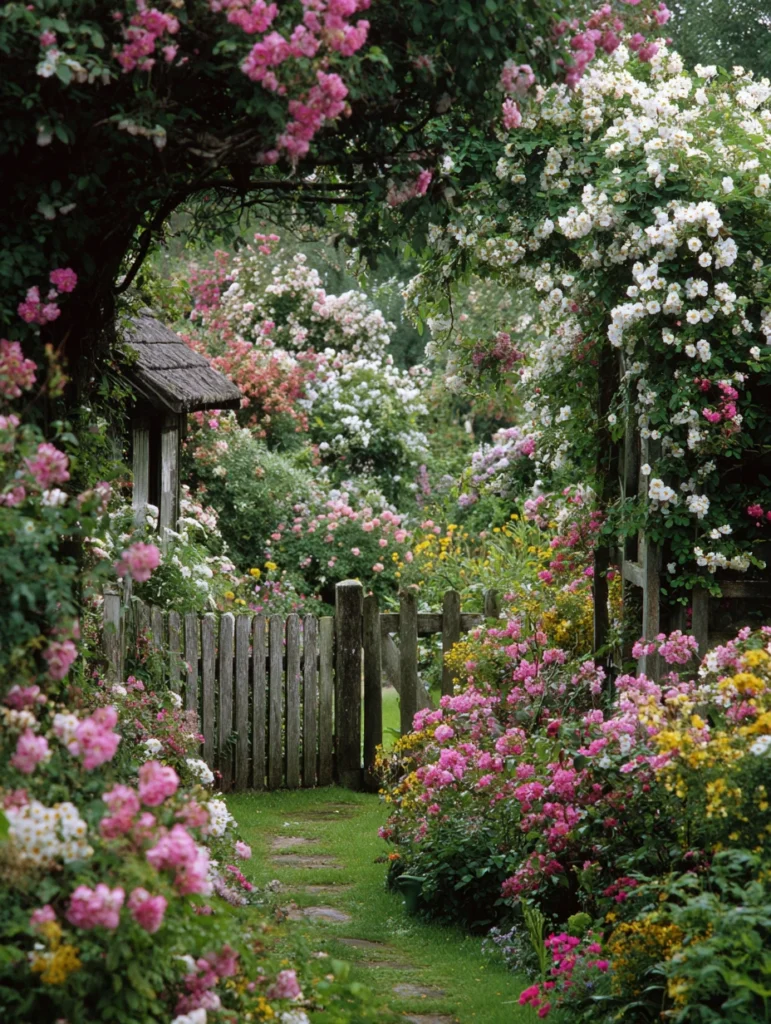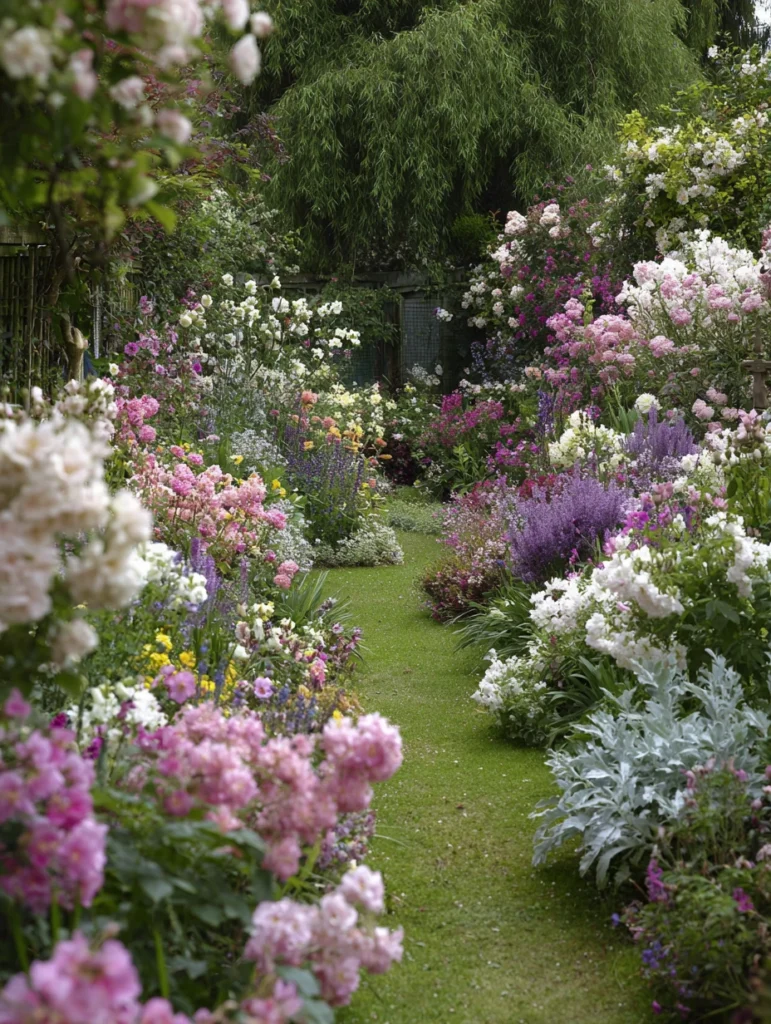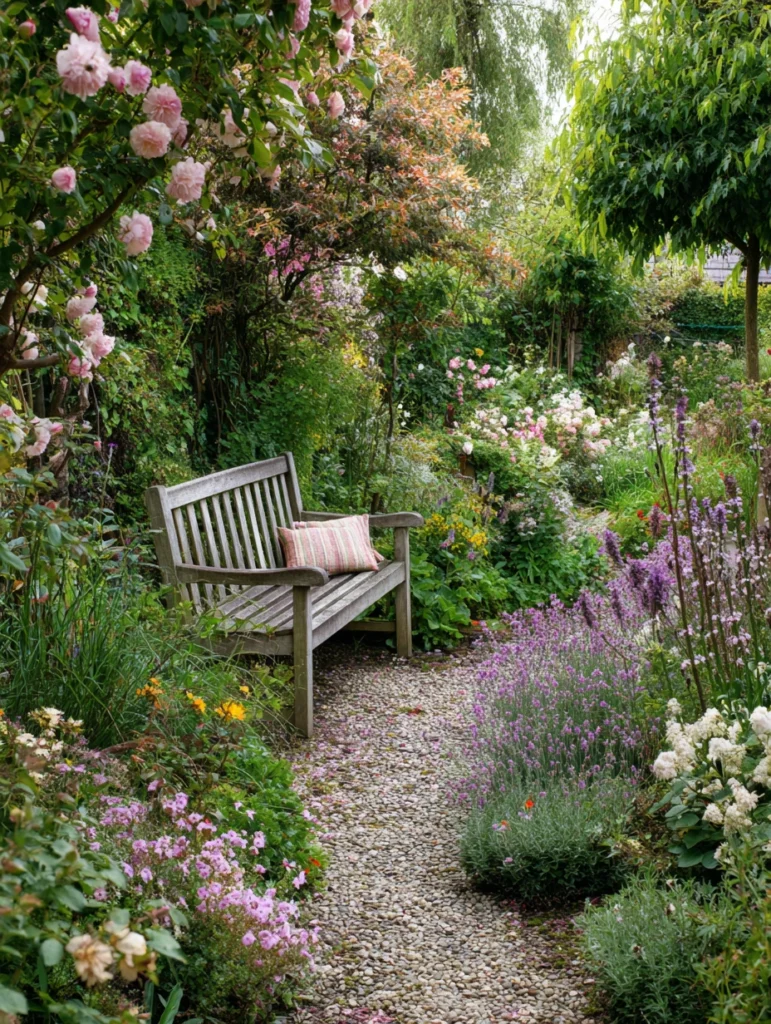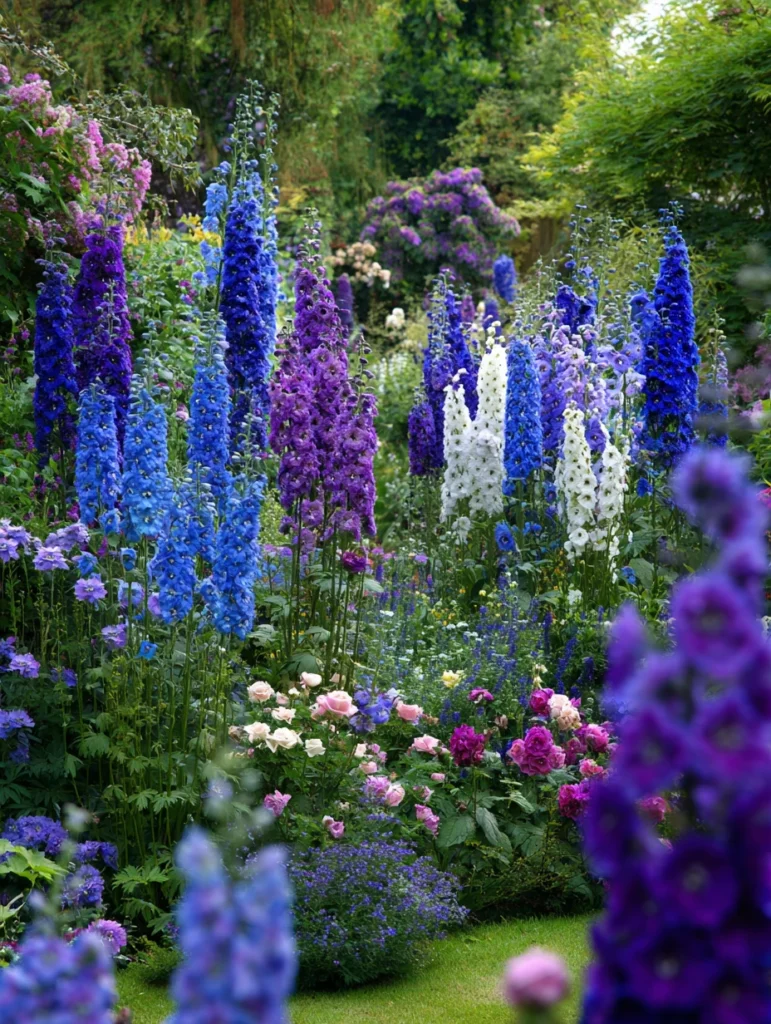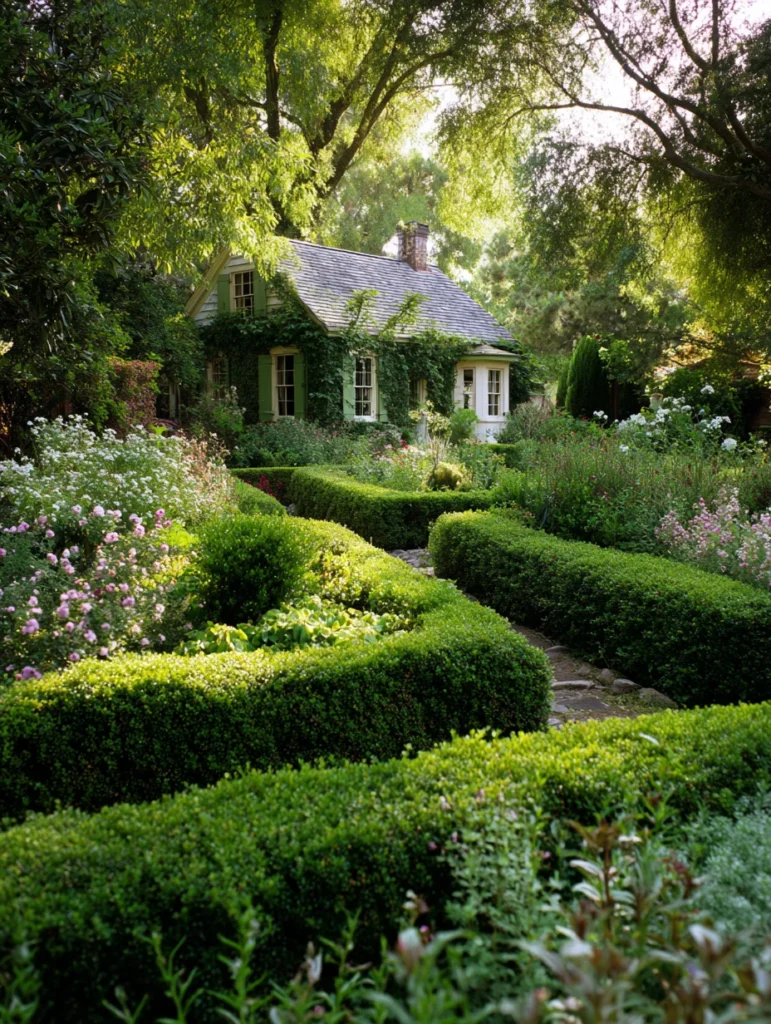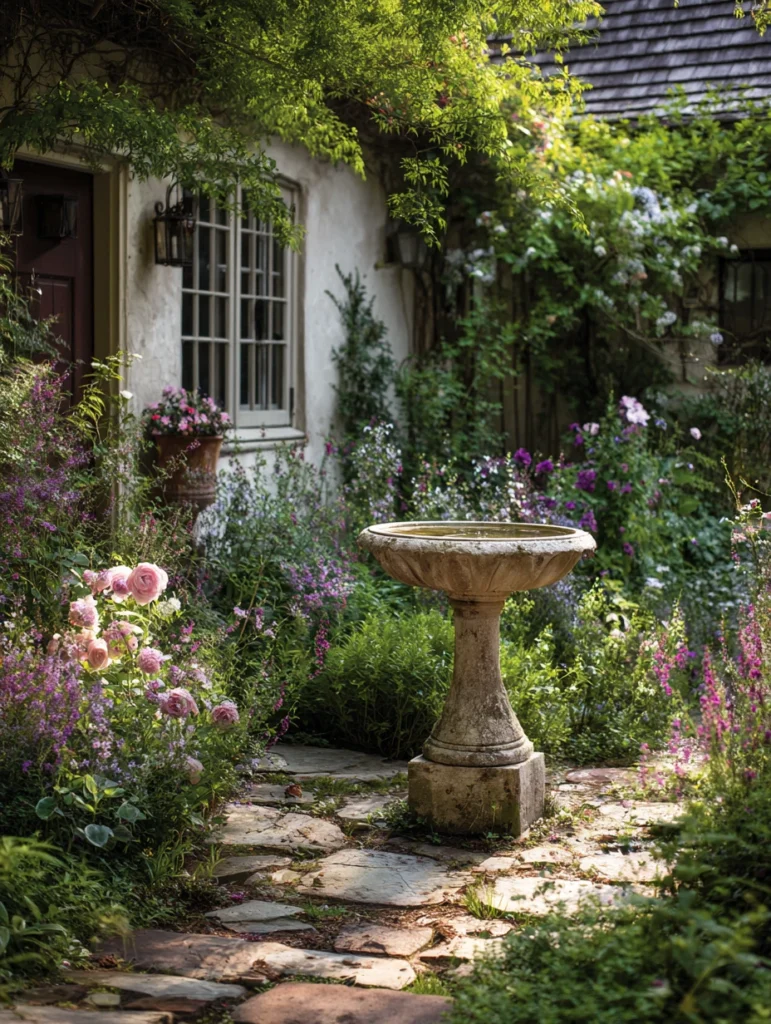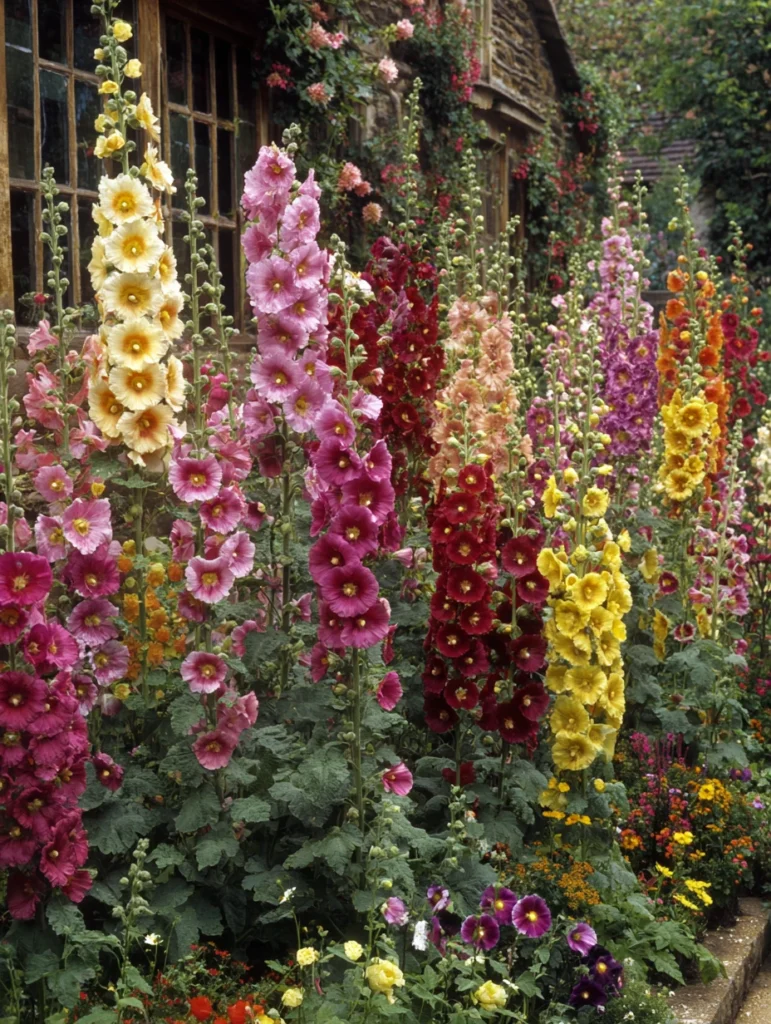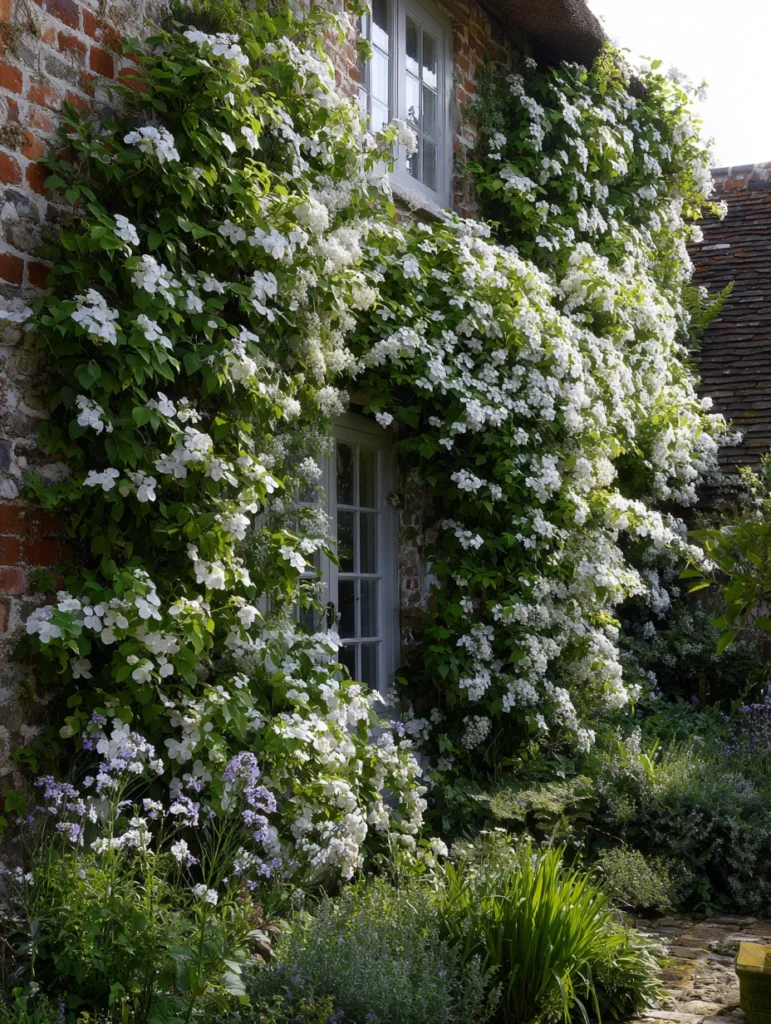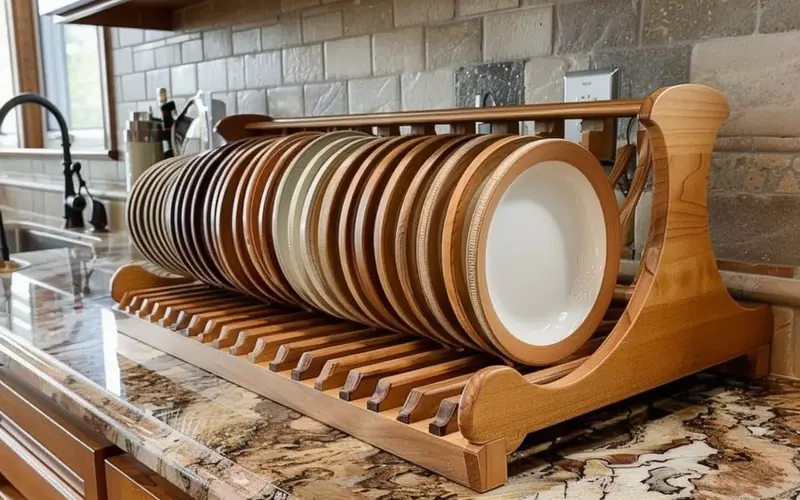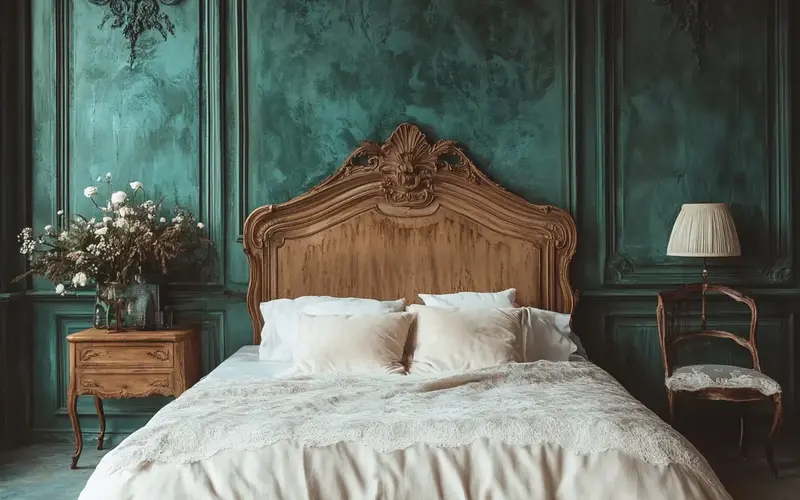You know that feeling when you scroll past those gorgeous cottage garden photos on Pinterest and think, “I could never pull that off”? Well, I’m here to tell you that’s complete nonsense. Creating an English cottage garden isn’t about having a green thumb or spending thousands of dollars – it’s about understanding a few simple tricks and letting nature do what it does best.
These gardens are designed to appear a little wild, a little messy, and wholeheartedly charming. So grab your gardening gloves (or don’t – we’re keeping this casual), and let’s turn your outdoor space into something that looks like it belongs in the English countryside.
1. Start With the Classics: Roses and Lavender
The Perfect Power Duo: Roses and lavender form the backbone of any English cottage garden, and honestly, can you think of a more iconic pairing? Roses bring a romantic, old-world charm, while lavender adds texture, color, and an incredible scent. I always recommend starting with climbing roses on a trellis or arbor because they create instant drama without occupying much ground space.
Why This Combination Works: These two plants have similar growing needs, making your life easier. They both thrive in full sun and well-drained soil, and are actually quite drought-tolerant once established. Lavender also acts as a natural pest deterrent, helping to protect your roses from aphids and other annoying pests.
Product Spotlight: The David Austin English Roses Bare Root Collection offers authentic English roses that’ll thrive in your cottage garden, providing the full, romantic blooms everyone loves. Pair these with Lavender Munstead Seeds or Plants, a compact variety perfect for edging pathways and creating that classic purple haze effect throughout your garden.
Read More: 21 Inspiring Vegetable Garden Design Ideas
2. Create Meandering Pathways That Go Nowhere Fast
Ditch the Straight Lines: One thing English cottage gardens absolutely nail is the art of the wandering path. Forget those rigid, straight walkways you see in formal gardens. You want curves, bends, and paths that seem to disappear around corners, making visitors curious about what’s next. Use gravel, stepping stones, or even old bricks laid in interesting patterns.
Materials That Actually Work: Pea gravel is my go-to recommendation because it’s affordable, easy to install, and has that perfect crunchy sound when you walk on it. Natural stone pavers look incredible, but they are more expensive. Use them sparingly as accents if you’re on a budget. Old reclaimed bricks add character and history to your garden, and honestly, the more weathered they look, the better.
Product Spotlight: Pea Gravel Natural Stone for Garden Pathways creates that authentic cottage garden crunch underfoot and drains beautifully after rain. Add Irregular Natural Stone Stepping Stones throughout the gravel to break up the path and make it more interesting – nobody wants to walk on gravel the entire time.
Read More: 21 Small Zen Garden Ideas for a Tranquil Home
3. Plant in Drifts, Not Rows (Trust Me on This)
The Drift Philosophy: Here’s where most people mess up – they plant one of everything in neat little rows like they’re creating a vegetable garden. English cottage gardens use “drifts,” which means planting groups of the same flower in irregular, flowing patterns. Think of it like painting with plants. You want clusters of color that blend into each other, not a lineup of individual soldiers.
How Many Plants Do You Need: For most perennials, I recommend planting in groups of at least five to seven of the same variety. This gives you enough mass to create that drifting effect. Don’t space them too evenly either – cluster some closer together and leave gaps where other plants can fill in. The goal is to make it look as if Mother Nature did the planting, not a grid-obsessed mathematician.
Product Spotlight: Mixed Wildflower Seed Collection for Cottage Gardens allows you to create those gorgeous drifts without spending a fortune on individual plants – simply scatter and watch them grow. The Cottage Garden Perennial Plant Collection offers pre-selected varieties that work beautifully together, eliminating the guesswork of color combinations.
Read More: 21 Cottage Garden Ideas for a Whimsical Space
4. Let Things Self-Seed (Yes, Really)
Embrace the Chaos: This might sound crazy if you’re used to manicured lawns, but one of the best parts of cottage gardens is letting plants do their own thing. When flowers like foxgloves, hollyhocks, and poppies go to seed, don’t deadhead everything religiously. Let some of those seeds drop and see what pops up next season. You’ll get surprises in unexpected places, and that’s precisely what makes cottage gardens so charming.
The Art of Controlled Wildness: Now, I’m not saying let your garden turn into a jungle. You still want some control here. Deadhead most of your blooms to encourage more flowers, but leave a few to seed. Pull out seedlings that pop up in truly terrible spots, but leave the ones that surprise you in interesting places. This balance between control and chaos is what separates a cottage garden from just… neglect.
Product Spotlight: English Cottage Garden Heirloom Seed Mix features varieties carefully selected for their self-seeding abilities and classic charm. Use Seed Saver Garden Bags to collect seeds from your favorite plants at the end of the season, letting you control exactly where those volunteers appear next year.
Read More: How to Design a Container Garden for Your Flowers
5. Add Vertical Interest With Climbers Everywhere
Go Up, Not Just Out: Limited space? Vertical gardening is your best friend. Climbing roses, clematis, sweet peas, and honeysuckle all love growing upward, and they transform boring fences, walls, and arbors into living tapestries. I’ve seen tiny gardens that feel huge because the owners used vertical space brilliantly. Every wall is an opportunity – stop letting them sit there naked.
Where to Add Climbers: Install trellises on your house walls (just make sure they’re at least a few inches away from the siding), cover your fences completely, and create arches over pathways. Climbing plants also work beautifully on pergolas, garden sheds, and even old ladders leaned against walls. The more vertical elements you add, the more three-dimensional and interesting your garden becomes.
Product Spotlight: Wooden Garden Trellis in Various Sizes offers sturdy support for climbing plants, providing a rustic and charming look – metal just doesn’t have the same cottage vibe. Add Heavy-Duty Plant Ties and Garden Twine to gently train your climbers where you want them without damaging stems.
Read More: Amazing Herb Garden Ideas for Your Outdoor Oasis
6. Mix Edibles Right In With the Pretty Stuff
Who Says Food Can’t Be Beautiful: Traditional cottage gardens always included edibles mixed right in with the ornamentals because, let’s be honest, people needed to eat. Tuck herbs like sage, thyme, and rosemary between your flowers—plant climbing beans on your arbors. Add strawberries as ground cover. Nobody will even realize they’re looking at a productive garden – it just looks gorgeous.
Practical and Pretty Combinations: Purple sage pairs beautifully with pink roses. Thyme makes an excellent pathway edging that smells incredible when you step on it. Rosemary grows into a substantial shrub that stays green year-round in mild climates. And don’t even get me started on how beautiful artichoke plants are – those silvery leaves are architectural masterpieces.
Product Spotlight: Herb Garden Seed Collection with Cottage Garden Favorites features varieties that look beautiful and taste amazing, providing you with double the value. The Strawberry Bare Root Plants for Garden Borders spread naturally to create living mulch while producing fruit – that’s efficient gardening.
Read More: 21 Corner Garden Ideas to Transform Your Backyard
7. Choose a Soft, Romantic Color Palette
Stick to the Sweet Stuff: English cottage gardens traditionally use soft pastels – pinks, purples, blues, whites, and touches of yellow. These colors create a dreamy, romantic atmosphere that feels calming rather than jarring. That doesn’t mean you can’t add pops of brighter color, but the overall vibe should lean gentle. Hot oranges and screaming reds work better in tropical or modern gardens.
Making Colors Flow: Plant your colors in gradual transitions rather than stark contrasts. Transition from pale pink to deeper pink, then to light purple, and finally to deep purple. White flowers act as buffers between colors that might clash. Silver-leafed plants, such as lamb’s ear, do the same thing. Think watercolor painting, not color-blocking.
Product Spotlight: Pastel Flower Seed Mix for English Gardens eliminates the guesswork of choosing complementary colors, providing a perfectly coordinated palette. Add White Flowering Perennial Collection to use as color separators and night garden stars – white blooms glow in moonlight.
Read More: Stunning Flower Bed Ideas for the Front of the House
8. Install a Weathered Bench or Two
Give People a Reason to Linger: What’s the point of creating something beautiful if nobody stops to enjoy it? Weathered wooden benches placed throughout your garden invite people to sit, relax, and truly appreciate the scent of those roses. Position them in spots with good views of your best plantings, or tuck them into secret corners for private reading nooks.
The Right Kind of Weathered: You want benches that look naturally aged, not cheap and falling apart. Teak and cedar weather beautifully over time, developing that silvery patina everyone loves. If you can’t afford wood, painted metal benches work too – just make sure they’re in soft colors like sage green or dusty blue. Avoid bright whites or blacks – they’re too stark for a cottage garden vibe.
Product Spotlight: The Wooden Garden Bench with Rustic Finish offers authentic cottage charm and develops character as it ages naturally in your garden. Enhance comfort with Outdoor Cushions in Floral or Striped Patterns, which add pops of color while making those benches actually comfortable enough for long sits.
Read More: 17 Garden Ideas for Small Spaces and Maximum Yield
9. Add Delphiniums for That Signature Cottage Look
The Blue Beauties: Nothing says English cottage garden quite like tall delphiniums in shades of blue, purple, and white. These towering perennials create vertical drama and that distinctly British feel. Yes, they require staking (those tall stems catch wind like sails), but the payoff is absolutely worth it. They bloom in early summer and often rebloom if you cut them back after the first flush.
Dealing With Their Drama: Delphiniums have a reputation for being finicky, but honestly, they just need good drainage and protection from slugs. Plant them in groups of at least three for maximum impact, and stake them early to prevent them from flopping over. They prefer cooler climates and may struggle in hot, humid areas, so be aware of your zone before making a commitment.
Product Spotlight: Delphinium Seeds Mixed Colors allows you to grow these cottage garden classics from seed, saving money while providing multiple plants. Use Garden Plant Stakes and Support Rings designed explicitly for tall perennials – your delphiniums will thank you when the wind picks up.
Read More: How To Create a Beautiful Rose Garden To Inspire You
10. Create “Rooms” With Hedges and Shrubs
Garden Architecture: Even informal cottage gardens benefit from some structure, and hedges provide it beautifully. Use boxwood, yew, or even informal flowering shrubs to create different “rooms” within your garden. This adds mystery and makes even small spaces feel larger because you can’t see everything at once.
Low-Maintenance Options: If formal hedge trimming sounds like torture, consider using shrub roses or hydrangeas as informal dividers instead. They provide structure without requiring precise shearing multiple times per year. Lavender hedges also work wonderfully and require minimal pruning – just a haircut after blooming keeps them tidy.
Product Spotlight: Boxwood Shrubs for Low Hedging create classic edging that stays green year-round and tolerates regular shearing beautifully. For larger dividers, consider Climbing Rose Pillar Collections, which grow on posts or pillars, creating living walls of flowers without the formality of clipped hedges.
Read More: 21 Japanese Garden Ideas for Serene Outdoor Spaces
11. Plant Foxgloves for Height and Drama
The Tall Drink of Water: Foxgloves bring serious vertical interest with their towering spires of tubular flowers. These biennials self-seed reliably, meaning you plant them once and they continue to reappear in different locations. They prefer partial shade and look absolutely magical when planted under trees or along woodland edges.
Safety First: Here’s the thing – foxgloves are poisonous if eaten, so keep them away from areas where small kids or pets might nibble. However, don’t let that deter you completely. They’ve been cottage garden staples for centuries because they’re simply stunning. Just use common sense with placement.
Product Spotlight: Foxglove Seeds in Mixed Colors offers classic spires in shades of pink, purple, white, and cream that reseed naturally. Pair with the Shade-Tolerant Perennial Collection to create a lush garden under trees where most flowers struggle to bloom.
Read More: 21 Stunning Mediterranean Garden Ideas To Inspire You
12. Add a Birdbath or Small Water Feature
Water Brings Life: Birds, bees, butterflies – they all need water, and adding a source brings your garden to life in ways you wouldn’t expect. A simple birdbath serves as a focal point while also fulfilling a practical purpose. If you’re feeling fancy, a small bubbling fountain adds soothing sound and keeps water fresh for wildlife.
Placement Matters: Put your birdbath where you can see it from inside your house – watching birds bathe never gets old. Ensure it’s located near shrubs or trees where birds can retreat if they feel threatened. Keep the water shallow (one to two inches) and change it regularly to prevent mosquitoes from breeding.
Product Spotlight: The Cast Stone Birdbath with Aged Finish appears to have been in your garden forever, while providing essential water for birds and pollinators. Add Solar Powered Fountain Pump Kit to keep water moving and prevent stagnation – moving water stays cleaner and attracts more wildlife.
Read More: How To Create a Magical DIY Fairy Garden for Your Backyard
13. Plant Peonies Because They’re Non-Negotiable
The Spring Showstoppers: Peonies are essential in cottage gardens, and honestly, if you skip them, are you even trying? These lush, ruffled blooms in shades of pink, white, and coral appear in late spring and stop people in their tracks. Yes, they bloom for only a few weeks, but their foliage remains attractive throughout the season, and those flowers are well worth the wait.
Long-Term Investment: Peonies require several years to reach their full potential, but once established, they can live for decades. I’ve seen peony plants that are older than the people tending them. They require cold winters to bloom well, so check if your climate is suitable for them. Plant them in the fall, don’t bury the crown too deep, and be patient.
Product Spotlight: Peony Root Collection in Classic Cottage Colors features varieties specifically selected for their full, fragrant blooms and long-term reliability. Use Garden Markers and Plant Labels to remember which varieties you planted where – you’ll thank yourself when they bloom years later.
Read More: Urban Gardening Solutions: Creating a Small Patio Veggie Garden
14. Let Grass Grow Longer in Some Areas
The Meadow Effect: Here’s a low-maintenance trick that looks intentional – let some lawn areas grow longer and plant them with spring bulbs or wildflowers. This creates a naturalistic meadow effect that complements cottage garden aesthetics perfectly. Mow pathways through it so people know it’s deliberate, not neglected.
When and How to Mow: Cut meadow areas just twice per year – once in early spring before bulbs emerge, and once in late summer after wildflowers have set seed. This allows plants to complete their life cycles while preventing them from becoming truly overgrown. The reduced mowing saves time, water, and helps pollinators.
Product Spotlight: Wildflower and Grass Meadow Mix for Cottage Gardens includes both flowers and native grasses that work together to create that effortless meadow look. Mark your mowed pathways with Natural Wood Garden Edging so everyone knows the longer grass is intentional design, not laziness.
15. Add Hollyhocks Against Walls and Fences
The Background Beauties: Hollyhocks are those tall, stately flowers that seem to have walked straight out of a Victorian painting. They grow best when planted against walls or fences where they get support and protection. These cottage garden classics bloom in summer with flowers stacked up their tall stems like colorful UFOs.
Managing Their Quirks: Hollyhocks often act like biennials, blooming in their second year, but they self-seed so reliably that you’ll have continuous blooms once established. They can develop rust disease (characterized by orange spots on leaves), but honestly, in cottage gardens, a slight imperfection is okay. Simply remove the affected leaves if they bother you.
Product Spotlight: Hollyhock Seeds in Vintage Colors brings those tall, old-fashioned blooms in shades of pink, red, yellow, and almost-black burgundy. Support them with Garden Stakes for Tall Flowers – these tall beauties can topple in the wind without proper support.
16. Plant Catmint as a Lavender Alternative
The Underrated Hero: Catmint resembles lavender but handles heat and humidity much better, making it ideal for those in challenging climates. It blooms profusely with soft, purple-blue flowers and silvery foliage, creating a romantic haze reminiscent of lavender. Plus, it’s virtually indestructible once established.
Why It Works Everywhere: Unlike lavender, which can be picky about drainage and winter wet, catmint tolerates various conditions without complaint. It blooms for months if you cut it back after the first flush, and deer generally leave it alone. Bees and butterflies absolutely love it, so you’re helping pollinators too.
Product Spotlight: Catmint Walker’s Low Plants offer months of purple-blue blooms and excel in heat, handling it better than traditional lavender while maintaining their cottage garden charm. Pair with Butterfly and Bee Friendly Flower Seed Mix to create a pollinator paradise that buzzes with life all summer.
17. Create a Cutting Garden Within Your Garden
Flowers You Can Actually Cut: What good is a flower garden if you feel guilty cutting blooms for your house? Designate one area specifically for cutting flowers – plant extras of everything you love so you can harvest guilt-free. Include long-stemmed varieties like zinnias, cosmos, sweet peas, and dahlias that make gorgeous bouquets.
Growing specifically for Cutting: Space cutting garden plants closer together than you would ornamental plantings – you want straight stems, not branching. Pinch back plants early to encourage the growth of more stems. Cut flowers early in the morning when they’re most hydrated, and always use clean, sharp scissors.
Product Spotlight: Cut Flower Seed Collection for Cottage Gardens features varieties specifically bred for long stems and extended vase life, allowing you to create endless bouquets. Store your harvest properly with Flower Food Packets that keep cut blooms fresh for over a week.
18. Add Sweet Peas for Scent and Color
The Fragrance Champions: Sweet peas win the award for most heavenly scent in the cottage garden. These climbing annuals need cool weather to thrive, so plant them early in spring. Train them up trellises, obelisks, or teepees, and they’ll reward you with months of delicate, ruffly flowers that smell absolutely incredible.
Growing Tips: Sweet peas need regular cutting to keep blooming – the more you cut, the more they produce. They also require consistent moisture and dislike hot weather. In warm climates, treat them as cool-season annuals and plant them in the fall or very early spring.
Product Spotlight: Heirloom Sweet Pea Seeds in Mixed Colors revive the intense fragrance that modern hybrids have lost, in favor of bigger blooms – go old-school here. Grow them on Garden Obelisk Trellises that create vertical focal points while supporting these enthusiastic climbers.
19. Use Climbing Hydrangeas on Walls
The Shade Solution: Got a north-facing wall that nothing seems to like? Climbing hydrangeas thrive there, slowly covering brick or stone with lush foliage and white lacecap flowers. They’re slow starters – sometimes taking three years to really take off – but patience pays off with a spectacular living wall.
Long-Term Commitment: These are plants you install and forget about. They cling to walls using aerial roots, so you don’t need to tie them up constantly. Just give them a few years to establish, and they’ll basically take care of themselves while providing year-round interest.
Product Spotlight: Climbing Hydrangea Plants transform shady walls into lush vertical gardens with fragrant white blooms and beautiful foliage. Help them establish faster with Plant Root Stimulator applied during the first growing season – it encourages strong root development.
20. Plant Ground Covers Instead of Mulch
Living Mulch: Why buy bags of wood chips when you could plant low-growing flowers instead? Ground covers like thyme, alyssum, and creeping Jenny fill gaps between larger plants, suppress weeds, and look way better than bare mulch. They’re also self-sustaining once established.
Best Ground Covers for Cottage Gardens: Creeping thyme handles foot traffic and smells amazing when stepped on. Alyssum self-seeds and creates clouds of tiny white or purple flowers. Lady’s mantle has beautiful scalloped leaves and chartreuse flowers. Pick varieties that suit your conditions and let them spread.
Product Spotlight: Creeping Thyme Seeds for Garden Pathways creates fragrant, walkable ground cover that survives light foot traffic while looking beautiful. Mix in Alyssum Carpet of Snow Seeds for continuous white blooms that fill gaps and reseed naturally year after year.
21. Install a Garden Arbor as a Focal Point
Create an Entrance: Garden arbors instantly add structure and create inviting entrances that draw people in. Cover them with climbing roses, clematis, or honeysuckle, and you’ve got an Instagram-worthy focal point that looks like it’s been there forever—position arbors at the beginning of paths or between garden rooms.
Materials That Work: Wooden arbors weather beautifully and perfectly complement the cottage aesthetic – let them age naturally to develop a silvery gray patina. Metal arbors work too if they’re in dark colors like black or bronze rather than shiny silver. Avoid anything too ornate or fussy – simple designs work best.
Product Spotlight: The Wooden Garden Arbor with Lattice Sides provides instant structure and support for climbing plants, creating a classic cottage garden entrance. Train vigorous climbers with Soft Garden Ties and Plant Clips that won’t damage delicate stems as plants grow.
Final Thoughts
There you have it – your complete guide to creating an English cottage garden that looks like it’s been there for generations, even if you’re starting from scratch. The beauty of this style is that it gets better with age, so don’t stress about perfection.
Plant things, see what works, move stuff around, and let nature do some of the work. Your garden will develop its own personality over time, and that’s precisely what makes cottage gardens so special. Now get out there and start planting!





